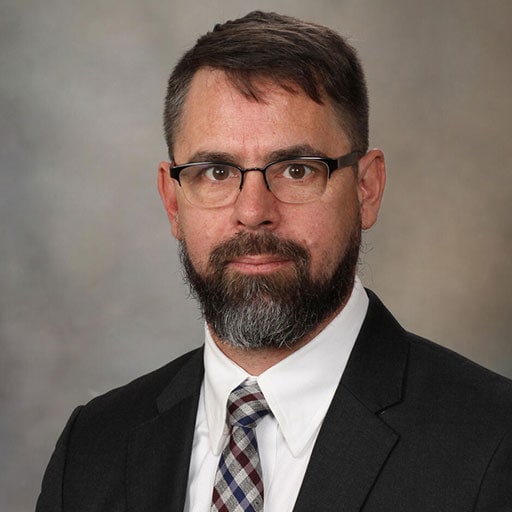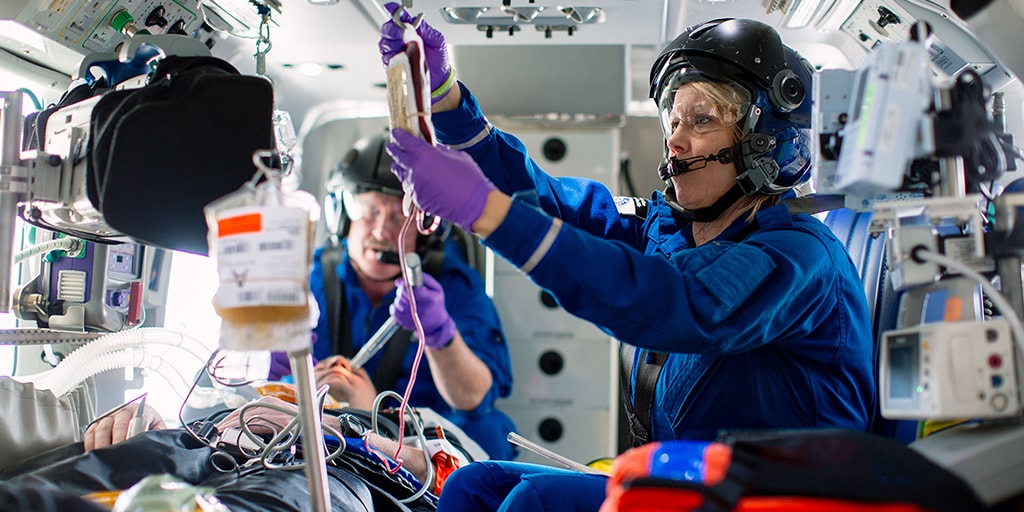
Colin Bucks, M.D.
Medical School: Temple University School of Medicine
Residency: Temple University Hospital
Fellowship: Albert Einstein Medical Center
Interests: Emerging Infectious Diseases, Disaster Preparedness

Residents participate in a longitudinal EMS experience with exposure to all aspects of EMS and prehospital medicine. This begins with two one-week participatory experiences during the PGY-1 year and continues with regularly scheduled EMS experiences throughout both the PGY-2 and PGY-3 years. For those with interest in EMS, additional experiences can be arranged, including working as an assistant medical director for regional EMS agencies.
Mayo Clinic Ambulance Service is the advanced life support (ALS) ambulance that provides primary 911 response services to the Rochester area. The ambulance service also provides 911 ALS response to several other communities in Minnesota and Wisconsin, including St. Cloud, Duluth, Mankato, Eau Claire, and several others.
Resident physicians ride-along with ALS units with graduated responsibility during training. Initial experiences during the PGY-1 year are focused on exposure to the prehospital environment and the inherent challenges, while senior residents are expected to provide education and assist paramedics with medical decision making and patient care.
Physicians from the Division of Prehospital Care as well as our EMS Fellow perform independent integrated emergency field response using a dedicated emergency response vehicle. Residents ride along with these physicians regularly to learn more about EMS and the prehospital environment as well as the role of an EMS medical director. In addition to the full complement of emergency medical equipment carried on an ambulance, the emergency response vehicle is equipped with a point of care ultrasound device and equipment for advanced airway management.
Mayo One is the flight and critical care branch of the Mayo Clinic Ambulance Service. Mayo One is comprised of four EC145 helicopters and a King Air 350C airplane. The helicopters are operated from three bases: on the roof of St Mary’s Hospital in Rochester, MN, in Mankato, MN, and in Eau Claire, WI. The fourth helicopter is maintained as a backup to allow for continued service while maintenance is performed. The airplane is based out of the Rochester International Airport.
Resident physicians optionally participate in flight shifts during all three years with graduating expectations. During the PGY-1, residents are typically scheduled for two 12-hour flight shifts in an observer role. Senior residents are scheduled for additional flight shifts with expanding roles on the flight team.

Mayo Clinic Ambulance Service operates an emergency communications center that is a secondary Public Safety Answering Point (PSAP) that provides Emergency Medical Dispatch (EMD) services including pre-arrival instructions for the Rochester region, as well as several other areas of the state. They also dispatch for all our ground and air services, and coordinate communication between EMS and the emergency department. Residents spend time in the ECC observing the process to understand the challenges of communication in an emergency and the techniques to overcome these challenges.
Mayo Clinic Ambulance Service is growing and expanding our offerings in the community through our community paramedic (CP) program. We currently have daily coverage to provide assessments in patients’ homes in an effort to avoid unnecessary hospitalization, shorten hospital stays, and improve health. The CP program operates a clinic for the homeless and has programs in place for management of CHF, diabetes, and other medical problems. Residents can spend time with CPs learning about the services they provide.
Mayo Clinic Ambulance Service is one of fewer that 200 ambulance services participating in a Medicare pilot program designed to avoid unnecessary emergency department visits by allowing reimbursement for alternative transport destinations as well as treatment at the scene, as opposed to transport to the emergency department. Through a collaboration with the Department of Emergency Medicine Telemedicine program, paramedics can access an emergency physician via video who can assist with treatment and transport decisions.

Outside of the city of Rochester, EMS services are provided by a patchwork of volunteer BLS agencies, many of which are members of the Southeast Minnesota EMS Consortium. Mayo Clinic Division of Prehospital Care physicians provide medical direction for these agencies and interested residents can work as assistant medical director for these agencies longitudinally throughout residency. This includes opportunities to perform quality assurance, training, and other medical direction tasks.
This is a 20-month paramedic training program operated in collaboration with Mayo Clinic, Mayo Clinic Ambulance, and Rochester Community and Technical College (RCTC) in Rochester, Minnesota. Residents spend time at the paramedic school providing education to paramedic students, particularly surrounding skill acquisition and medical decision making.
Mayo Clinic provides on-line medical direction via phone and radio to services throughout southeast Minnesota to assist paramedics and EMTs with complex prehospital decision making. Residents participate both by providing this medical direction while working in the emergency department, but also in performing quality assurance for medical control calls.
Sztajnkrycer, program director and prehospital physician for the EMS Fellowship, is a former sworn part-time deputy sheriff and serves as medical director for the Southeast Minnesota Tactical Medicine Consortium, Rochester Police Department, the Olmsted County Sheriff's Office, and as both Medical Director and Tactical Physician for the Emergency Response Unit and Austin Special Incident Response Team (SWAT). As a result, opportunities exist for select residents interested in tactical medicine to gain exposure and experience in this area.